Newsletter
Current
Previous
|
June 2014
|
|
|
|
|
 OUR DAILY BREAD:
We take our daily bread for granted. So long as we can buy it or grow it, we have no problems. OUR DAILY BREAD:
We take our daily bread for granted. So long as we can buy it or grow it, we have no problems.
In December 2013 we featured American agronomist Norman Borlaug as our Green Hero, a name little known by the majority except in the scientific community, but his work in developing semi-dwarf, high-yield, disease-resistant wheat varieties is credited with saving a billion people from starvation. He was dubbed 'the father of the Green Revolution', receiving the Nobel Prize in recognition of his achievement. He warned that this was just a breathing-space in the race to feed the burgeoning world population (latest estimate 7 billion, to become 9 billion by 2050!)
How perverse, then, that in the UK we are responsible for throwing away tons of unwanted food. Read Anne Booth's account of our April talk by Emma Barnett of WRAP on how to reduce food waste and make the most of the food we buy. None of us would admit to throwing food away, but most of us have probably been guilty of this at some time. Pig bin collections are no longer an option, but John Booth visits a site where they treat unwanted food waste in Oxfordshire.
A COMMUNITY ORCHARD OF OUR OWN:
Ever seen apples or other fruit rotting in people's gardens where it is seen unworthy of giving the time of day to pick? This would not happen if Jean Hackett gets her way in the creation of a Community Orchard in Earley. People involved in this would have a vested interest. Things have moved on since we published Jean's article in our last newsletter. Please contact Jean on 0118 986 1115 or e-mail if you want to be part of this exciting project. Not only is it a good coming together of community, but it also benefits wildlife like bees. Just think of all the crops we rely on for bee pollination.
THE FLOWERING OF EARLEY:
Bees need flowers and this brings me neatly on to the Flowering of Earley. Much of rural Earley has disappeared under bricks and mortar, but there can still be room for flowers. Read about our flower pockets in Earley, and the campaign by Alan Titchmarsh to use our verges as sites for conserving wild flowers.
|
|
|
|
Community orchard update, 14th May 2014
 Since I had an article on this topic published in the Spring editions of the EEG and MERA newsletters, I have received 4 expressions of interest in helping to establish a community orchard, 1 offer to pay for plants or equipment, and 1 message mentioning possible locations. Since I had an article on this topic published in the Spring editions of the EEG and MERA newsletters, I have received 4 expressions of interest in helping to establish a community orchard, 1 offer to pay for plants or equipment, and 1 message mentioning possible locations.
I have also spoken informally to the deputy Town Clerk of ETC, who thought the council would be quite amenable to a group setting up an orchard on council land.
In addition, I have contacted Andy Glencross of Countryside Services at WBC, who seemed quite positive about such a scheme for Earley, and would be able to give help and advice about grants and sources for plants.
A meeting with Jennifer Coupland, of WBC Parks and Open Spaces department, was very positive; Grahame and his Wednesday volunteers were also there. We discussed the possibility of using the green space behind the Instow Road houses and the Laurel Park children's playground, which Jennifer agreed was under-utilised. The idea would be to plant 20 - 30 fruit trees there in the winter; there will be blossom (and bees) in spring, shade as the trees grow for family picnics, as well as fruit in later years.
I have sent a proposal to Jennifer Coupland, as requested, and await a response. She also felt that, if we were given the go-ahead, WBC might be able to give some practical help in preparing the site for planting.
A further suggestion for a location is near the BMX track in Paddick Drive, which is leased by ETC from WBC, and again I would expect to plant 20 - 30 trees. We would be able to present the same proposal as for WBC to the ETC Amenities and Leisure sub-committee for their consideration.
Jean Hackett
About two-thirds of Britain's orchards have been lost since 1960!
|
|
On a sunny afternoon in April, three representatives of the Earley Adopt-a Street Initiative (EASI) met the Lord Lieutenant of Berkshire, the Queen's official representative in the county. We were presented with a certificate in recognition of our nomination for a Queen's Award to Voluntary Service. All the Berkshire charities receiving nominations were at the ceremony, 22 in all, demonstrating a wide range of voluntary activities across the community.
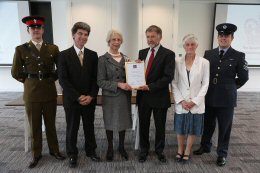
| Grahame Hawker, Brian and Jean Hackett
with the Lord Lieutenant |
EASI's nomination for a Queen's Award was ultimately unsuccessful. However, in the words on the Adjudicators, "The Committee considered your group's nomination to be of a high standard and recommended that Earley Adopt-a-Street Initative (EASI) be kept in the nominee pool for consideration next year." So watch this space next year. Of course, the more volunteers we can sign up the better - see the contact details in Bits & Pieces.
EASI was formed as a joint venture between EEG and Maiden Erlegh Residents' Association, and its 260-plus volunteers help to keep Earley's streets and green places free from litter.
Brian Hackett
|
|
UK households waste about £12.5 billion worth of good food and drink a year. Most of this shocking waste could be avoided. If we could stop throwing good food away, we could save the equivalent in carbon emissions of taking 1 in 4 cars off UK roads.
 At the EEG meeting on April 28th, Emma Barnett from the Waste Resources Action Programme (WRAP) gave a presentation to the group. Following this we split into small groups and went through some worksheets to make us think and question our knowledge and habits. At the EEG meeting on April 28th, Emma Barnett from the Waste Resources Action Programme (WRAP) gave a presentation to the group. Following this we split into small groups and went through some worksheets to make us think and question our knowledge and habits.
For example, we may think it unnecessary and bad for the environment, but modern packaging helps keep food fresher longer - shrink-wrapped cucumbers last 3 times longer. Re-sealable cheese packets, meat sealed in divided portions and sliced bread in half-size loaves all help to cut waste. Greenhouse gas emissions created by throwing away the food are many times higher than those produced by the packaging.
Portion size was another surprise to some of us. What seemed to be a very small amount of rice was the advised portion size. Measuring amounts of pasta, cereal, rice and meat is important as it helps to reduce leftovers which may be thrown away.
Emma suggested freezing any surplus food for using later in curries, stews, etc. Frozen food keeps 'forever', i.e. never becomes unsafe, but deteriorates in quality.
For lots of ideas, recipes and information see their website
Emma gave us copies of the Handbook and worksheets if anyone would like to talk about the topic or run a session at their club or group. Please get in touch with me if you'd like these. I also have free pasta measures and storage bag clips.
Anne Booth 0118 9868260
So what to do with all this waste food?
Oxfordshire have found a way
 Two EEG members joined a Reading Friends of the Earth visit to Agrivert's anaerobic digestion plant near Wallingford in May. Two EEG members joined a Reading Friends of the Earth visit to Agrivert's anaerobic digestion plant near Wallingford in May.
The privately-owned plant was built to service a 15-year contract with Oxfordshire County Council to treat 20,000 tonnes of food waste per year. It achieved full power in September 2013.
The picture shows us with our hosts and part of the site building (only 3 staff are employed on the highly-automated site) and four of the digester tanks.
Oxfordshire has a weekly domestic food waste collection, which makes its fortnightly general waste collection more acceptable. Waste from other sources is also processed at the plant.
After de-packaging and macerating and removing contaminants, the waste is fed into a system of 5 large tanks where it breaks down (typically over 120 days at about 36°C) to produce biogas (methane and CO2) and a liquid fertiliser called digestate.
The biogas drives two 1.2 MW generators which have run at 96% capacity since September - about 11% is used by the plant. They claim to generate enough electricity to power over 4,800 homes.
The picture below shows the 'reception area' where a truck has just tipped domestic waste into a large underground trough, whence it is macerated and turned into 'soup' to feed the digesters.
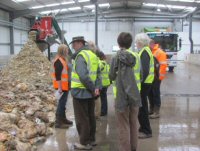 Food waste often arrives in bags from the caddies used in Oxfordshire, and/or includes plastics or metal - this unsuitable material is automatically removed (orange peel is also removed!) and is seen coming out of the machinery on the left of this picture. It can then become refuse-derived fuel. Food waste often arrives in bags from the caddies used in Oxfordshire, and/or includes plastics or metal - this unsuitable material is automatically removed (orange peel is also removed!) and is seen coming out of the machinery on the left of this picture. It can then become refuse-derived fuel.
The technology seemed to work and the site seems well-managed - and it's good to know putrescibles are not going to landfill where they could slowly emit methane (the potent greenhouse gas).
FoE nationally supports Anaerobic Digestion as a valuable part of waste management strategy, but any proposals should take into account costs of collection, transport etc. for a sound assessment.
John Booth
|
|
Still on the subject of food……
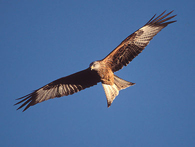 Feeding of red kites in gardens: The red kite is now one of Earley's most familiar birds, thanks to the reintroduction in the Chilterns from the late 1980s. Since then their numbers have increased greatly and part of my research at the University of Reading has been to investigate why. A few years ago Dr Mark Fellowes and I carried out surveys outside supermarkets across the Reading area (thank you if you took part!), and found that around 5% of households feed kites in their gardens. Surprised that so many people feed kites, we set up an online survey to find out more, especially as there have been some media reports that some food being given might be bad for the birds. We also wanted to work out how much food is given. Feeding of red kites in gardens: The red kite is now one of Earley's most familiar birds, thanks to the reintroduction in the Chilterns from the late 1980s. Since then their numbers have increased greatly and part of my research at the University of Reading has been to investigate why. A few years ago Dr Mark Fellowes and I carried out surveys outside supermarkets across the Reading area (thank you if you took part!), and found that around 5% of households feed kites in their gardens. Surprised that so many people feed kites, we set up an online survey to find out more, especially as there have been some media reports that some food being given might be bad for the birds. We also wanted to work out how much food is given.
Several years ago the groups involved in reintroducing the kites made some recommendations for those feeding kites in their garden. These included giving meat that contains skin and/or bone and that is raw, and not giving processed meats (e.g. sausages). These suggestions are to more closely mimic the natural diet of kites, and avoid potentially harmful additives such as salt. They also suggested only giving small amounts, and not to provide food every day. to encourage the kites to also look for 'natural' food.
When we checked our survey results against these recommendations, we were encouraged to find that most garden feeding falls within them (even though people might not know about the recommendations). Very few people said that they gave processed meats (under 1/4 ) and around 80% said that they gave meat with skin/bone and that this was uncooked. Similar numbers did not feed kites every day and only gave small amounts of food - the average amount taken by kites per garden per day was very small - only enough to provide between 1/4 and 1/8 of the amount that an adult kite needs to eat each day.
Melanie Orros (Twitter: @ecolmel)
If you would like more details the scientific paper about this survey is free online.
|
|
|
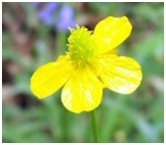 Local Wild Flowers Local Wild Flowers
Seek and ye shall find! Ranunculus auricomus, known as Goldilocks Buttercup, is a perennial species of buttercup. Many of the flowers do not have a full complement of petals. It's an indicator of ancient woodland. Renee Grayer visited Pearman's Copse, on the Shinfield border, at Easter time, She wrote 'Pearman's Copse was very flowery when John Booth and I went there last Thursday. There was a good display of Bluebells and thousands of Lesser Celandine. But the most unusual feature was the enormous number of Goldilocks Buttercups (Anne Booth already emailed me to look out for those). I have never seen such a large population of that species in any wood in the greater Reading area. Usually there are only a few small patches.' Wild orchids have also been found in a couple of sites in Earley. Wokingham Borough Council has taken a sympathetic cutting regime to these.
The flowering of Earley
Nature has been given a helping hand by Grahame Hawker of Earley Town Council and willing volunteers. Not only do we have the pleasure of seeing wild flowers, but it provides welcome food and shelter to so much wildlife. Look for the wildflower sites in Maiden Erlegh Reserve: the wildflower meadow next to Oak Wood, a real pleasure to walk through in summer, a makeover of the butterfly garden, and wild flower pockets in Instow Road. There are also newly-planted verges on Rushey Way . Did you see the cowslips? Paddick Drive has a verge planted last year with flowers for attracting butterflies and bees (see photo below, its second year, taken May 2014 by Anne Booth).
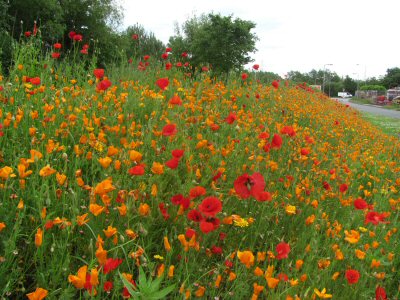
Earley is a little ahead of the game in 'flowering up' verges. (See previous item). Alan Titchmarsh is heading a campaign by PLANTLIFE to urge councils to adopt Plantlife's Guide to Good Road Verge Management to help wildlife.
 At present Wokingham Borough Council is not signed up. If you choose to send the letter, which is on the website, to WBC be sure to include the guidelines in it. At present Wokingham Borough Council is not signed up. If you choose to send the letter, which is on the website, to WBC be sure to include the guidelines in it.
|
|
Now for something completely different …
|
OUR EARLEY BAGWORMS
"What on earth are you looking at?" It was a fair enough question addressed to me by a passer-by. After all, it is not every day of the week that one encounters someone peering intently at an electricity pole in Silverdale Road, and obviously finding it of absorbing interest. However, I did retrieve at least a modicum of self-respect (tinged, I suspect, with a little sympathy), when I pointed out the object of my interest was not in fact the pole per se, but an animate object attached to it.
"It looks just like a bunch of twigs all stuck together", commented the passer-by, a fair enough description to which I replied that unlikely though it may seem, it was in fact an insect. "Oh yes, of course, a Caddis fly larva. We used to catch them in the stream."
In terms of appearance it was a reasonable enough guess except that Caddis fly nymphs are denizens of ponds and streams and most unlikely to be found climbing an electricity pole in Silverdale Road. In fact the object of our attentions was the caterpillar of a moth, Psyche castra, which to the best of my knowledge
|
does not have the luxury of an English name, but belongs to an odd but interesting family of moths known as bagworms (Psychidae). The females of most species are wingless and almost wholly helpless, and are little more than egg-producing machines - in many species they do not even emerge from the larval case, spending their entire lives there. The males however are quite good flyers. As the name bagworm implies, the larva inhabits a strong portable silk case covered with fragments of stick or other oddments in which it also pupates. Our friend could be forgiven for thinking it was some kind of terrestrial Caddis larva for there is indeed quite a similarity. They feed on a variety of foodstuffs such as lichens, grasses, detritus such as decaying plant material, dead insects etc.
To see these interesting little creatures, which are only about 15mm long, all you need to do is wander along the roadsides anywhere in Earley in the summer months, and as likely as not you will find them clinging to walls, fences, poles etc.. Then you can impress your companions with your identification skills and entomological knowledge!
|
|

Male
|

Case and young larvae
|
Alan Broodbank
|
|
|
NEWS FROM BEYOND EARLEY
The Leuser Ecosystem : Not heard of it?
 Neither have most of us, but amazingly it is considered to be one of the most important conservation areas on earth. Located in the north of Sumatra, it is home to 105 recorded species of mammals, 382 species of birds, and at least 95 species of reptiles and amphibians (54% of Sumatra's terrestrial fauna). It is considered to be the last place in SE Asia of sufficient size and quality to maintain viable populations of many rare and charismatic species including tiger, orangutan, rhino, elephant, and clouded leopard.
Neither have most of us, but amazingly it is considered to be one of the most important conservation areas on earth. Located in the north of Sumatra, it is home to 105 recorded species of mammals, 382 species of birds, and at least 95 species of reptiles and amphibians (54% of Sumatra's terrestrial fauna). It is considered to be the last place in SE Asia of sufficient size and quality to maintain viable populations of many rare and charismatic species including tiger, orangutan, rhino, elephant, and clouded leopard.
As you might imagine, the threats to it are enormous - poaching, logging, agricultural expansion and construction. Now, the Aceh government is considering plans for a mine to open right at the edge of the jungle. A petition to the Indonesian President to protect the area has been raised with over 100,000 signatures. The outcome is as yet unknown. (Several fascinating videos, 'Eyes on Leuser', are on YouTube.)
|
|
EARLEY GARDEN SURVEYS
Our garden survey news from Gillian and Margaret for April:
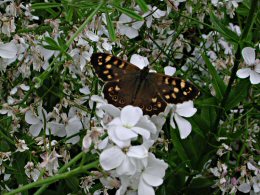 Photo of speckled wood by David Jupe April was a great month for butterfly sightings. Holly blue, orange tip and peacock were seen in both gardens. Gillian was also visited by brimstone, red admiral, and speckled wood. She commented, 'Good to see the butterflies'.
Margaret also spotted large white and small white.
The pond came to life in Margaret's garden, with some well-developed frog spawn and pond skaters.
|
|
|
LOCAL FORTHCOMING EVENTS 2014
Sunday, June 22nd: 11.00 to 13.00 Dragonfly and Damselfly Walk, planned for last year but let's hope for better weather this time! Led by Mike Turton, Berkshire Recorder for these species. Location will be Thames Valley Park. Park along the road and meet by roundabout next to the security lodge. Please book beforehand (0118 969 4197 or by email ), in case it should be necessary to cancel due to adverse weather conditions.
July Walk: There will be a butterfly walk, location and date to be arranged, hopefully in the Moor Copse Nature Reserve, Tidmarsh but please consult posters on display boards and the website.
Saturday, August 2nd: 10.00 to 15.00 Join us for our annual Green Fair at the Maiden Erlegh Nature Reserve.
Wednesday, 6th August, Children's Annual Bug Hunt 10.00 to 12.00 Meet at the Interpretation Centre, Instow Road. Places must be booked as numbers are limited. Come prepared for any weather. Minimum age 4 years. Responsible adults to accompany children aged up to 8yrs. Contact Sheila Crowson on 962 0004 for details. Please give a contact number and information about any allergic reactions. Alternatively, enrol at the Green Fair. An afternoon session may be held if there is sufficient demand.
|
|
Bits and pieces
Don't forget. We're on Facebook now!
The Earley Environmental Group now has a Facebook presence. We will be using this in addition to the main website, the Yahoo Group and the Newsletter as a way of keeping everyone up to date with our activities and to let you know about upcoming events. Members are also welcome to post news stories or any photographs relevant to the group. If you are a Facebook user, please do join up - just search for 'Earley Environmental Group' and we should pop up. Look forward to seeing you on there. Mel Orros
EASI (Earley Adopt-a-Street Initiative) would like more volunteers. Help keep your street clear of litter. Everything provided. Phone Brian Hackett on 0118 986 1115 or email
Can you offer active help to EEG? If so, phone 0118 962 0004 or go to the website. We would welcome more member involvement. If you have no expertise and would like to get involved, you may be able to give practical help. Perhaps help with distributing the newsletter hard copies, or maybe you have graphic design skills (for occasional posters, leaflets), computer skills, any other skills to offer.
Join the EEG Yahoo Group and post your sightings and messages. You’ll find a link to Yahoo on our website.
EEG committee members can be found on www.earleyenvironmentalgroup.co.uk under Contacts, or phone 0118 962 0004
For Wildlife Survey Forms, go to the website or phone Earley Town Council on 0118 986 8995
Comments or contributions to the newsletter to: the Editor or 2 Reeds Avenue, Earley, RG6 5SR. We would welcome short contributions from members to the newsletter.
If you know someone who would like to join EEG, membership forms are available from Earley Town Council, 0118 986 8995, on the website under Downloads , or send an e-mail to the Membership Secretary. Please inform Liz if you intend to change e-mail or address at 50 Kenton Rd, Earley RG6 7LG, or send her an e-mail.
|
SUPPORT YOUR LOCAL SHOPS
Pet Fayre 9 Maiden Lane Centre Lower Earley : A small independent shop, with bird feeders of all kinds, a variety of bird feed, large bags of which the shop is willing to deliver locally, or pick it up in your car from the back of the shop, tel. 0118 9266512, e-mail or go on the comprehensive website
|
|
Thanks to ORACLE Corporation for reproducing our newsletter on recycled paper. Oracle is the world's second largest software company, situated at Thames Valley Business Park in Earley. Oracle UK adheres to the ISO14001 Environment Standard which confirms Oracle has considered and acted upon its environmental impact. As part of Oracle’s corporate social responsibility they support a number of local groups, including us. They have given us valuable support in reproducing the hard copies of our newsletter in colour, as well as printing posters and membership leaflets for us to distribute to libraries, schools etc. |
|